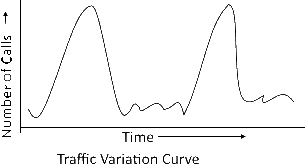Telephone Traffic & Trunking Principle
TELEPHONE TRAFFIC
Telephone traffic means, number of subscribers .trying to contact other subscribers. It has an interesting similarity with vehicular traffic on a road in a city. In practice, it is very difficult to predict. that-at a particular time someone wants to make a call. It may happen any time. So it is a probability that someone needs to make a call.
For a given area, the distribution of calls is not uniform but it varies from time to time. There is seasonal variation of calls also. An average over a year for day to day variation gives an idea, that how many people are making calls at a particular time. This variation is shown by a curve in figure

A thorough study of the telephone traffic gives an idea to decide as how many selectors are to provide at each stage, and how should they be interconnected, so that the ideal objective of maximum efficiency with minimum cost can be approached as far as possible. It is now necessary to define certain basic terms so that a quantitative meaning can be attributed to the telephone traffic.
BUSY HOUR
As we know that the telephone traffic varies from time to time, so any calculations based on the average will be misleading for the requirements most of the time. To get a reasonable standard of service, the calculations for the numbers of switching equipment should be based on some internationally agreed criteria. This internationally agreed criteria, on which all the calculations are based is the busy hour. The busy hour is defined as a period of sixty consecutive minutes during which the telephone traffic is the highest. The busy hour varies from exchange to exchange depending on its location, and community interest of its subscribers.
BUSY HOUR CALLING RATE
It is defined as the average number of calls per subscriber during the busy hour.
HOLDING TIME
This is called holding time because during this time, the switches in the exchange are held busy. The holding time per call consists of two parts: Operating time, is the time during which the call is set up and after conversation the switches are released and Conversation time, is the actual time used by the subscriber in talking. From the subscriber point of view the conversation time is important while for the telephone administration the total time is of importance because the switches remain busy until both the subscriberput down their receivers.
TRAFFIC UNIT - THE ERLANG
The telephone traffic is measured in the unit called "erlang", which is defined as the product of the number of calls perbusy hour and the average holding time per call, measured in hours. The abbreviation used for erlang is E. Thus the telephone traffic A in erlang is given by:
A = N x T erlang
Where A = telephone traffic in erlang
N = number of calls in the busy hour
T = average holding time of calls expressed in Hours.
An erlang can also be defined as one call of one hour duration.
THE PRINCIPLE OF GRADING (GRADE OF SERVICE)
The efficiency of the telephone company should be such that, it has to provide the best service to its subscribers, i.e., the number of the switching equipment should be such that no call should fail to develop.
Sometimes during the busy hour, the telephone traffic increases to the highest. To cope with this the company has to provide the necessary switching equipment, which are very expensive. These equipment will be in use only for a limited period of time and will remain idle for the rest of the day. So the cost of installation will increase greatly. This cost should be made reasonable by losing a small part of the traffic. So in practice, a certain percentage of subscribers fail to get a connection due to non-availability of switching equipment. The probability that a certain percentage of subscribers will not be able to make a call is called the grade of service.
The overall grade of service, which consists of the individual grades of service in different stages of the exchange, is find out by the probability of failing to make a connection between the two parties. The overall grade of service during the busy hour can be used to calculate the number of switching equipment and circuits.
The greater part of the overall loss is allowed in those sections, which have the highest annual costs. The costs of the junction circuits, i.e., connection between exchanges, will be higher than those of the selector stages in the exchange. So it is more economical to tolerate a lower grade of service, i.e., higher losses, in the junction circuits. Thus different selector stages are generally calculated with a grade of service of 0.001 to 0.01(1 call per 1000 to 1 call per 100), whereas for junctions (both local and long distance circuits) a grade of service of 0.005 to 0.05(5 calls per 1000 to 5 calls per 100) is adopted. The local calls will therefore have best grade of service because only selector stages are involved.
The overall grade of service per connection may have a value of 0.06 to 0.07 without considerably reducing the service to the subscribers. This is due to the fact that there are chances a call is not completed for other reasons, e.g., the called party being engaged or not obtainable.
The minimum grade of service will occur only in the busy hour, so that in most cases, the actual grade of service will be better.
